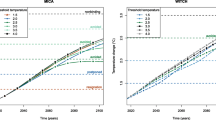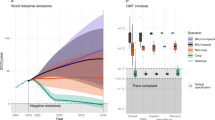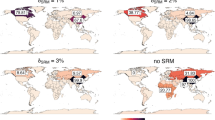Abstract
We study a dynamic game of climate policy design in terms of emissions and solar radiation management (SRM) involving two heterogeneous countries or group of countries. Countries emit greenhouse gasses (GHGs), and can block incoming radiation by unilateral SRM activities, thus reducing global temperature. Heterogeneity is modelled in terms of the social cost of SRM, the environmental damages due to global warming, the productivity of emissions in terms of generating private benefits, the rate of impatience, and the private cost of geoengineering. We determine the impact of asymmetry on mitigation and SRM activities, concentration of GHGs, and global temperature, and we examine whether a tradeoff actually emerges between mitigation and SRM. Our results could provide some insights into a currently emerging debate regarding mitigation and SRM methods to control climate change, especially since asymmetries seem to play an important role in affecting incentives for cooperation or unilateral actions.
Similar content being viewed by others
Notes
Throughout this paper, the game with two heterogeneous countries applies equally to two heterogenous groups of countries.
This measure can be associated for example with how productive a country is in using energy to produce output.
As mentioned in the introduction, the use of geoengineering methods could intensify ocean acidification. Although the natural absorption of CO\(_{2}\) by the world’s oceans helps to mitigate the climatic effects of anthropogenic emissions of CO\(_{2}\), it is believed that since geoengineering will cause an increase in GHG emissions, the resulting decrease in pH will have negative consequences, primarily for oceanic calcifying organisms, and so there will be an impact on marine environments. For a discussion of damage functions related to climate change, see Weitzman (2010).
A situation can be envisioned in which SRM generates extra benefits to a country, in addition to those accruing from a decrease in average global temperature, due for example to favorable change in regional climatic conditions. In this case \(c_{i\zeta }\) could take negative values.
SRM can be regarded as increasing the global albedo, since it blocks incoming radiation. We use a sensitivity function which is linear in aggregate SRM instead of a nonlinear function in order to simplify the exposition.
At this stage we do not consider the transportation of heat across the globe, which is a standard assumption of the EBCM developed by North (e.g., North 1975a, b, 1981; North et al. 1979). Thus we study a homogeneous-earth, zero-dimensional model. This allows us to obtain tractable results regarding the mitigation/geoengineering tradeoff. The analysis of the mitigation/geoengineering tradeoff in the context of a one-dimensional spatial model is an area for further research.
McClellan et al. (2012) perform an engineering cost analysis of systems capable of delivering 1–5 million metric tonnes (Mt) of albedo modification material to altitudes of 18–30 km. They compare the cost of aircraft and airships to the cost of survey rockets, guns, and suspended gas and slurry pipes for the delivery of stratospheric aerosol geoengineering at middle and high altitudes. They conclude that the most cost effective way to deliver material to the stratosphere at million tonnes per year is through the use of existing aircraft or new aircraft designed for the geoengineering mission.
Graphs of the optimal paths are available in Appendix A1 of the Working Paper version of the paper (http://wpa.deos.aueb.gr/wpa_show_paper.php?handle=1511).
Graphs are provided in A2 at http://wpa.deos.aueb.gr/wpa_show_paper.php?handle=1511.
List and Mason’s (2001) sources of asymmetry correspond to the intercept of marginal benefits from emissions (the \(A_{1i}\) in terms of our model), and the slope of marginal damages from global pollution (or \(c_{T}).\)
We run the following scenarios of asymmetric heterogeneity: \(+\)20 and \(-\)90 %; \(+\)20 and \(-\)70 %; \(+\)40 and \(-\)70 %; \(+\)40 and \(-\)90 %; \(+\)20 and \(-\)40 %; \(-\)20 and \(+\)90 %; \(-\)20 and \(+\)70 %; \(-\)40 and \(+\)70 %; \(-\)40 and \(+\)90 %; \(-\)20 and \(+\)40 %.
See Appendix A.4 at http://wpa.deos.aueb.gr/wpa_show_paper.php?handle=1511.
References
Athanassoglou S, Xepapadeas A (2012) Pollution control with uncertain stock dynamics: when, and how, to be precautious. J Environ Econ Manag 63:304–320
Barrett S (2008) The incredible economics of geoengineering. Environ Resour Econ 39:45–54
Barrett S, Lenton TM, Millner A, Tavoni A, Carpenter S, Anderies JM, Chapin FS III, Crépin A-S, Daily G, Ehrlich P, Folke C, Galaz V, Hughes T, Kautsky N, Lambin E, Naylor R, Nyborg K, Polasky S, Scheffer M, Wilen J, Xepapadeas A, de Zeeuw A (2014) Climate engineering reconsidered. Nat Clim Change 4:527–529
Basar T (1989) Time consistency and robustness of equilibria in non-cooperative dynamic games. In: van der Ploeg F, de Zeeuw AJ (eds) Dynamic policy games in economics. North-Holland, Amsterdam, pp 9–54
Basar T, Olsder GJ (1999) Dynamic noncooperative game theory. SIAM classics in applied mathematics, 2nd edn. SIAM, Philadelphia
Brock W, Engstrőm G, Grass D, Xepapadeas A (2013) Energy balance climate models and general equilibrium optimal mitigation policies. J Econ Dyn Control 37:2371–2396
Brock W, Engstrőm G, Xepapadeas A (2014) Spatial climate-economic models in the design of optimal climate policies across locations. Eur Econ Rev 69:78–103
Coakley JA (1979) A study of climate sensitivity using a simple energy balance climate model. J Atmos Sci 36:260–269
Coakley JA, Wielicki BA (1979) Testing energy balance climate models. J Atmos Sci 36:2031–2039
Crutzen PJ (2006) Albedo enhancement by stratospheric sulfur injections: a contribution to resolve a policy dilemma? Clim Change 77:211–220
Dockner E, van Long N (1993) International pollution control: cooperative versus noncooperative strategies. J Environ Econ Manag 25:13–29
Emmerling J, Tavoni M (2013) Geoengineering and abatement: a ‘flat’ relationship under uncertainty. FEEM Working Paper 31.2013
Held IM, Winton M, Takahashi K, Delworth T, Zeng F, Vallis GK (2010) Probing the fast and slow components of global warming by returning abruptly to preindustrial forcing. J Clim 23:2418–2427
Jones A, Haywood JM, Alterskjær K et al (2013) The impact of abrupt suspension of solar radiation management (termination effect) in experiment G2 of the Geoengineering Model Intercomparison Project (GeoMIP). J Geophys Res Atmos 118:9743–9752
Jorgensen S, Martin Herran G, Zaccour G (2010) Dynamic games in the economics and management of pollution. Environ Model Assess 15(6):433–467
Keith DW (2000) Geoengineering the climate: history and prospect 1. Ann Rev Energy Environ 25:245–284
Kravitz B, Robock A, Olivier Boucher O, Schmidt H, Taylor KE, Stenchikov G, Schulz M (2011) The geoengineering model intercomparison project (GeoMIP). Atmos Sci Lett 12:162–167
Lenton TM, Vaughan NE (2009) The radiative forcing potential of different climate geoengineering options. Atmos Chem Phys 9:5539–5561
List J, Mason C (2001) Optimal institutional arrangements for transboundary pollutants in a second-best world: evidence from a differential game with asymmetric players. J Environ Econ Manag 42:277–296
Lucht W et al (2002) Climatic control of the high-latitude vegetation greening trend and Pinatubo effect. Science 296:1687–1689
Manoussi V, Xepapadeas A (2013) Mitigation and solar radiation management in climate change policies. FEEM Working Paper 41.2013
McClellan J, Keith DW, Apt J (2012) Cost analysis of stratospheric albedo modification delivery systems. Environ Res Lett 7:34019
Millar-Ball A (2012) The Tuvalu syndrome. Clim Change 110(3–4):1047–1066
Moreno-Cruz JB (2010) Mitigation and the geoengineering threat. The selected Works of Juan B. Moreno-Cruz. http://works.bepress.com/morenocruz/3
Moreno-Cruz JB, Keith DW (2012) Climate policy under uncertainty: a case for solar geoengineering. Clim Change 121:431–444
North GR (1975a) Analytical solution to a simple climate model with diffusive heat transport. J Atmos Sci 32:1301–1307
North GR (1975b) Theory of energy-balance climate models. J Atmos Sci 32:2033–2043
North GR (1981) Energy balance climate models. Rev Geophys Space Phys 19:91–121
North GR, Howard L, Pollard D, Wielicki B (1979) Variational formulation of Budyko–Sellers climate models. J Atmos Sci 36:255–259
Randel WJ et al (1995) Ozone and temperature changes in the stratosphere following the eruption of Mount Pinatubo. J Geophys Res Atmos (1984–2012) 100(D8):16753–16764
Ricke K, Morgan M et al (2008) Unilateral geoengineering. Briefing notes, Council of Foreign Relations, Washington, DC
Robock A (2000) Volcanic eruptions and climate. Rev Geophys 38:191–219
Robock A (2008) 20 reasons why geoengineering may be a bad idea. Bull At Sci 64:14–18
Robock A, Marquardt A, Kravitz B, Stenchikov G (2009) Benefits, risks, and costs of stratospheric geoengineering. Geophys Res Lett 36:L19703
Secretariat of the Convention on Biological Diversity (2012) Geoengineering in relation to the Convention on Biological Diversity: technical and regulatory matters. Montreal, Technical Series No. 66
Shepherd JG (2009) Geoengineering the climate: science, governance and uncertainty. Royal Society, London
Weitzman ML (2010) What is the “damages function” for global warming—and what difference might it make? J Clim Change Econ 1:57–69
Wigley TML, Ammann CM, Santer BD, Raper SCB (2005) Effect of climate sensitivity on the response to volcanic forcing. J Geophys Res Atmos (1984–2012) 110(D9):D09107
Author information
Authors and Affiliations
Corresponding author
Rights and permissions
About this article
Cite this article
Manoussi, V., Xepapadeas, A. Cooperation and Competition in Climate Change Policies: Mitigation and Climate Engineering when Countries are Asymmetric. Environ Resource Econ 66, 605–627 (2017). https://doi.org/10.1007/s10640-015-9956-3
Accepted:
Published:
Issue Date:
DOI: https://doi.org/10.1007/s10640-015-9956-3
Keywords
- Climate change
- Mitigation
- Solar radiation management
- Cooperation
- Differential game
- Asymmetry
- Feedback Nash equilibrium




